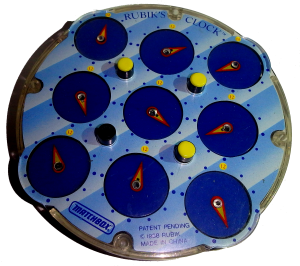The Rubik's Clock Mechanical Puzzle
The Rubik’s Clock is a puzzle invented and patented in the 1980’s. The patent was purchased by Ernő Rubik and marketed in 1988. It is arguably one of the simplest puzzles that is currently speedsolved in official WCA competitions and there has been quite a lot of discussion surrounding its future as an official event due to being completely different from all other twisty puzzle events currently hosted.
The World Record single is currently held by Nathaniel Berg at 3.73 seconds, and the World Record average is currently held by Evan Liu at 5.94 seconds. (2016)
Start the Rubik's Clock simulatorDesign
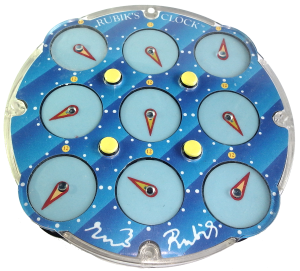
The back side
As mentioned above, the puzzle has a design that makes it completely unique when compared to other official WCA events. It features 9 clock faces on each side in a 3x3 grid, and four pins that can be pushed in or pushed out (this is reversed on the other side). There are also four corner gears, which control the movement of the clocks, which are also gears. The solved state of the puzzle is when all clocks on both side face 12 o’ clock (marked above each clock face).
The position of the pins determines which clocks are moved with which gears. Every clock surrounding a pin that is pushed up will be moved when you move the gear nearest to the pin. Therefore, if the upper-right pin was the only one pushed out, then moving the upper-right gear would rotate the four clocks surrounding the pin together. If the two upper pins were both pushed up and the two bottom pins were pushed down, then moving either or the top two gears would rotate every clock on the first two layers in the same direction.
However, this is reversed on the opposite side. If we have only the upper-right pin pushed out on the front, then on the back every pin except the upper-left pin will be pushed out. And by rotating the upper-right clock to move the four clocks surrounding the pin on one side, you will be rotating the gear touching a pushed down pin on the back, meaning that the corner clock is the only one that will move.
Scramble Notation
Clock notation is, like most other things about this puzzle, different to most other WCA puzzles.
UR4+ DR3+ DL5- UL3+ U2- R3- D1+ L0+ ALL4- y2 U4+ R0+ D4+ L4- ALL2- DL
This is an example of a scramble you might get. First, look at the letter(s) at the start of a section. For example, UR4+means that you put the top right pin up and the rest down, and then turn the top right gear 4 times clockwise (UR4+). Then you move on to the next one (DR3+ which is the bottom right pin up and the rest down, and then turning the bottom right gear 3 times clockwise), and then DL5-, then UL3+. + means clockwise, - means anti-clockwise, the number means how many times, and the letters mean what pin is up and what dial is turned.
Now, we get onto the ones where there is only one letter, and it will be one of U, R, L, or D. U2- means that you put the two top pins up and the two bottom ones down, then the 2- means you turn one of the top two pins twice anti-clockwise (it doesn’t matter which top pin) and then move on. Apply the same logic for R3-, D1+ and L0+. The L0+ means that you don’t turn it at all, so you can skip it. It is just left in for ease, as it cuts out the necessity for scrambler programs to check for ones where there is a 0.
Next is the ALL4-. This means that you put all the pins up, and turn any one of the dials 4 times anti-clockwise. Then the y2 means just flip it 180º horizontally. After that, just follow the same logic as above until you reach the final ALL2-. Then after that there will be 0-4 two letter sections. In this scramble there is only one, DL, which means that you put all the pins down then put the bottom left pin up.
How to solve the Rubik's Clock?
As a result of this difference, the clock is frequently regarded as a hard puzzle to solve. In fact, it is easy. Unlike the majority of puzzles, which have algorithms and methods, the clock is solved intuitively. The sequence in which the faces are solved is the only similarity between solves. This is not to say that the clock cannot be algorithmically solved, but that intuitive solving is more efficient.
Cross
To start, pick a flat face of the clock and hold it with all the pins up, so that they are longer on the side facing you, and with 12 o'clock facing up. 12 o'clock is usually marked by a red notch. Then, pick one of the clock faces that is not a corner or the center. For ease, let’s call them ‘edge’ clock faces. Then, check if the hand on that face is pointing towards the same point on the clock as the center one is. To help you to check, you can put all the pins up and then turn one of the dials until the center one is pointing to 12 o’clock. If it is, pick a different one and follow the same steps.
If not, put down the two pins closest to it.
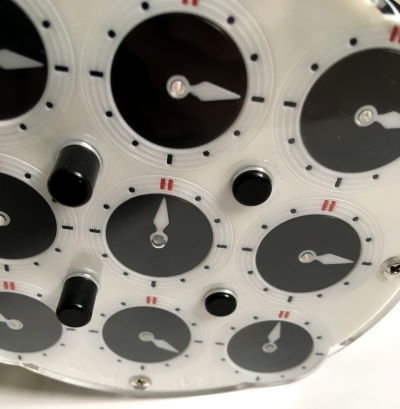
For example, if you picked the top one, you would put down the top left and top right pins. If you picked the right one, you would put down the top right and bottom right pins. Then, once those pins are down, turn one of the opposite dials until the center hand is pointing to the same point on the clock as the one you are solving. So if you were doing the top one, you would turn either the bottom left or bottom right dials. Then, once that face is solved, repeat the steps for the other 3 faces.
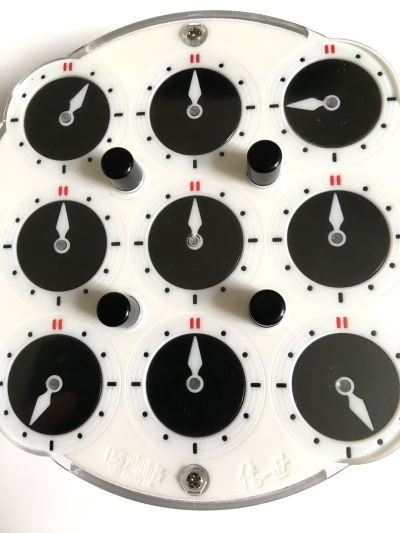
Cross on the other side
This is a repeat of the step before this, but on the other side. Before starting this step, put all the pins up. Then, as long as you do not turn the wrong dial or put the wrong pin down, the cross on the other side will remain solved.
Start off this step by looking at a clock face that is not a corner or edge and putting down the two pins nearest to it, same as above. Once that is done, turn one of the opposite dials until the center dial points to the same point as the clock face you were looking at. Then, repeat for all the other faces that make up the ‘cross’.
Once they are all solved, put all the pins up and turn any one of the dials until all of the hands that make up the cross are facing 12 o’clock. Then, if it is your first time, or you feel as though you might have messed something up, check the initial cross to ensure that that is still solved and pointing to 12 o’clock.
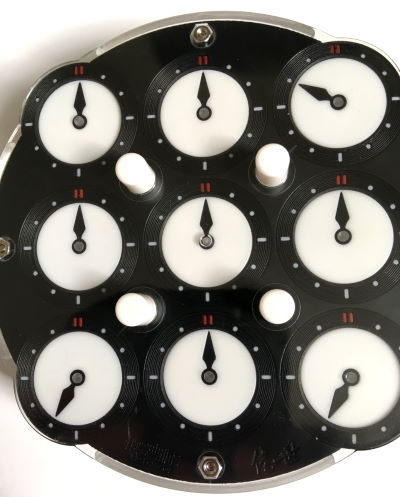
Corner clock faces
This step is the final step. It will solve all the corner clock faces on both sides. To start this step, move all the pins up, and ensure that all non corner clock faces are pointing to 12 o’clock. Then, pick a corner clock face that is not pointing to 12 o’clock and put down the pin nearest to it.
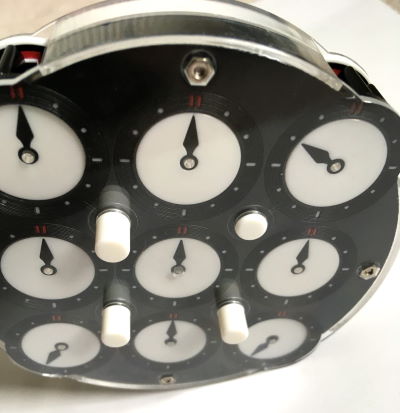
For example, if you pick the top right corner, you then put down the top right pin. Once you have put down the pin, turn the opposite dial, or any dial but the one in the same position as the pin you put down. If you put down the top left pin, turn the top right, bottom right, or bottom left dial. Turn the dial until the ‘edges’ and the center and any already solved corners are pointing to the same point as the ‘corner’ you are solving. Then, move on to the next corner and do the same. Once all the corners are pointing to the same point as the ‘edges’ and the center, put all the pins up and turn any one of the dials until all the clock faces are pointing to 12 o’clock.
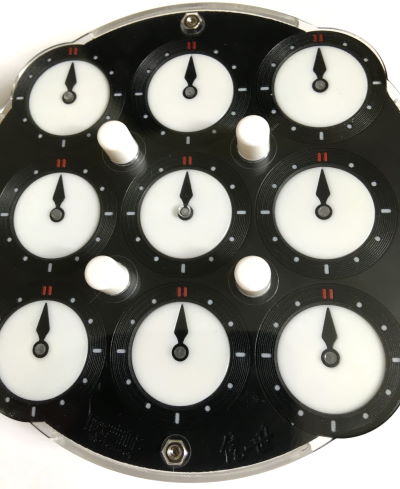
Solved Rubik's Clock
Finally, check the other side to ensure that everything is solved on that side too. If it is, you have solved it! If not, try again!
To conclude, the Rubik’s Clock is a fairly simple puzzle, and it is a good start for somebody who wants to move off of NxN puzzles or simply does not have the patience to learn the original cube.
